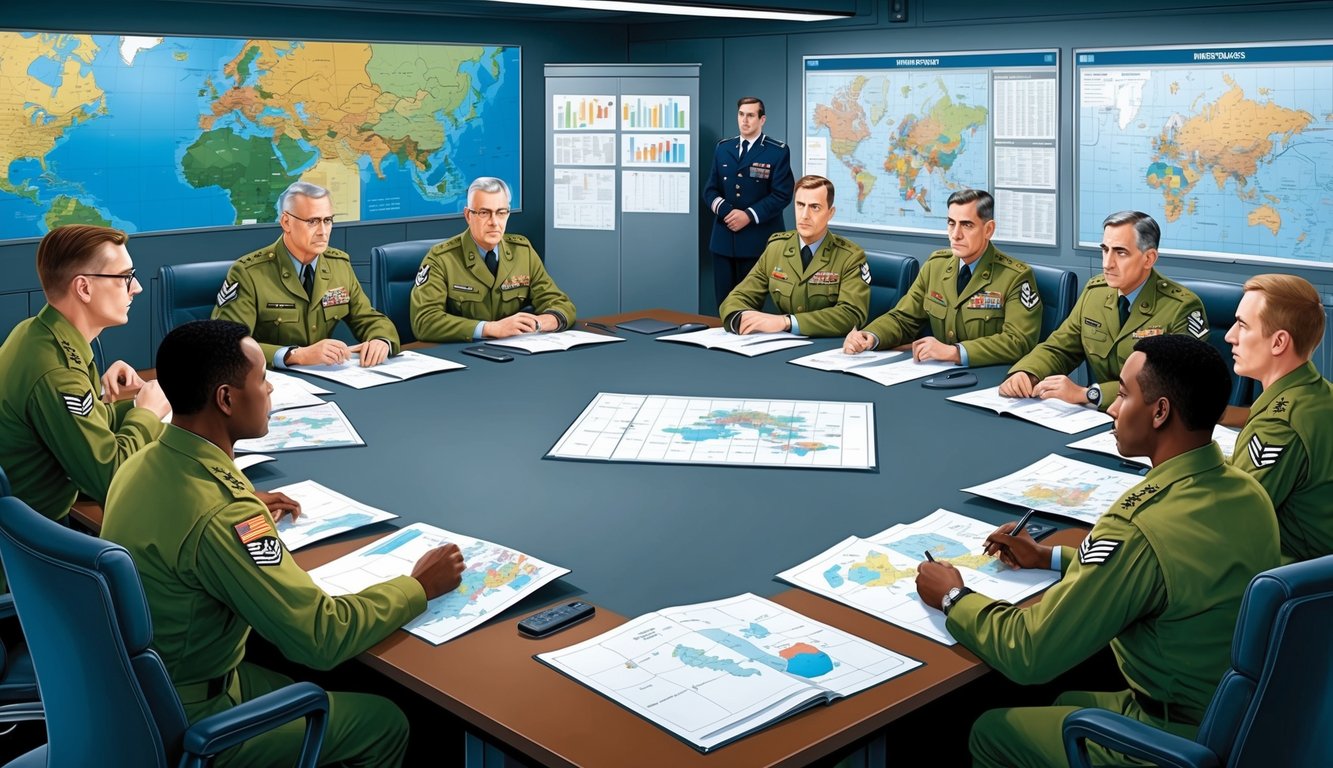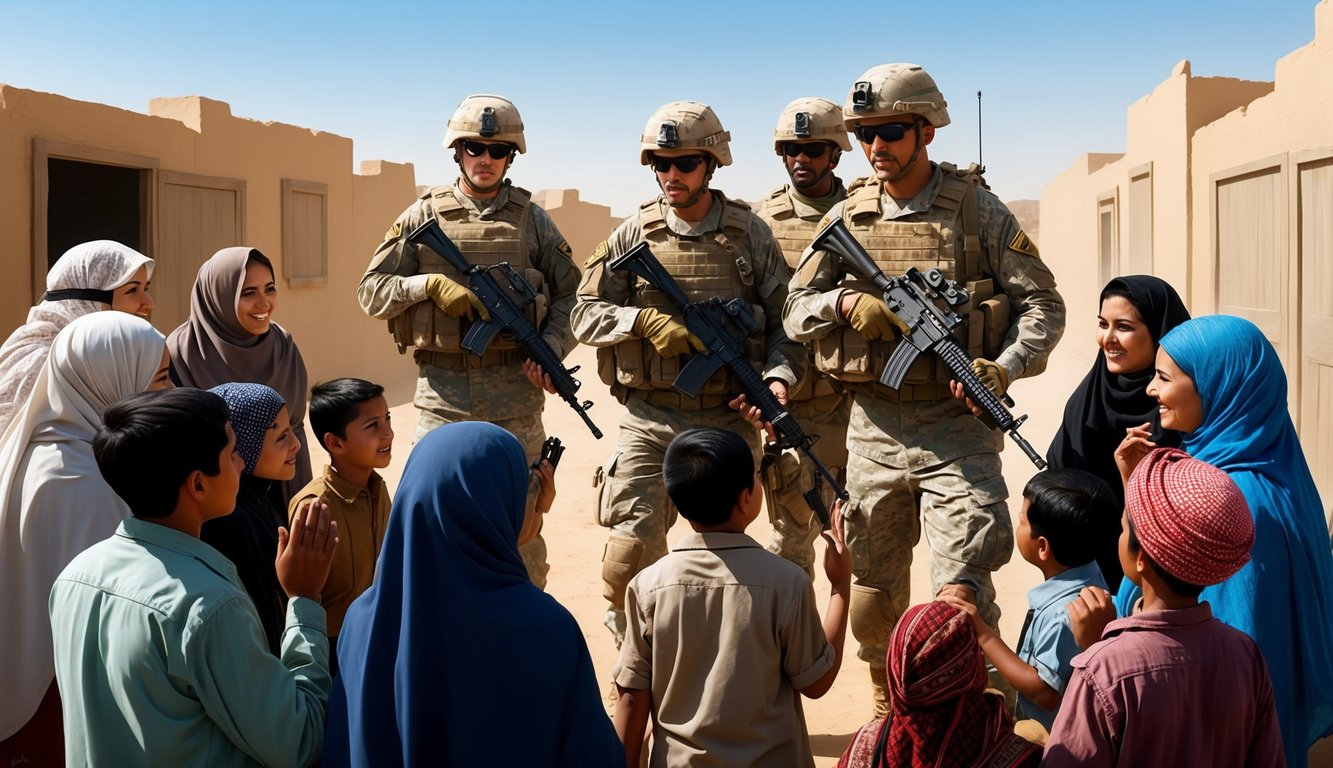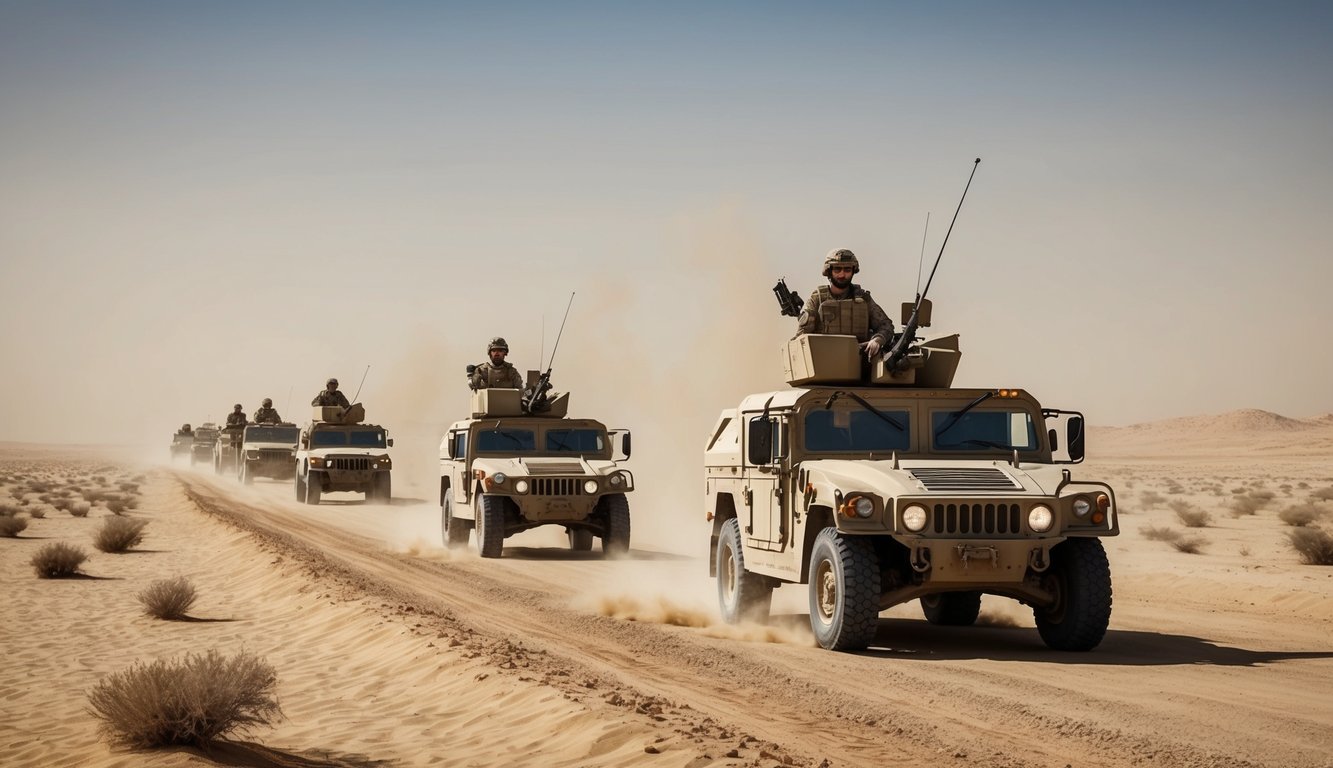“`xml
The presence of U.S. military forces in Iraq has been a nuanced and evolving matter since the invasion in 2003.
Although American troops remain in the country, their numbers are smaller compared to the peak of the conflict. As of 2024, agreements have been made between the U.S. and Iraq to gradually conclude the American-led coalition’s military operations, with plans for U.S. forces to vacate several long-established bases.
This strategic shift reflects the changing conditions within the region and the Iraqi government’s aspiration for increased independence.
Although the Islamic State has been significantly weakened, concerns regarding stability and security still persist.
The U.S. continues to offer training and support to Iraqi forces, yet the nature of this alliance is evolving.
You may wonder how this situation affects the future of Iraq and the wider Middle East.
As U.S. troops decrease their presence, questions emerge about Iraq’s capacity to ensure security and counter potential threats.
The changing landscape also underscores the intricate relationships involving Iraq, the United States, and other regional players.
Key Takeaways
- U.S. forces are set to depart from several long-standing bases in Iraq as part of a new agreement.
- The military mission led by the American coalition in Iraq is winding down while still providing support to Iraqi forces.
- Ongoing security dilemmas and regional dynamics will influence the future of military engagement in Iraq.
Historical Context of Military Involvement in Iraq
Iraq’s military history has been shaped by numerous conflicts, invasions, and power struggles.
Foreign interventions and internal conflicts have profoundly transformed the country’s political landscape throughout the last few decades.
The Gulf Wars and Their Legacies
The Persian Gulf War was triggered by Saddam Hussein’s 1990 invasion of Kuwait.
You may recall the swift international coalition led by the U.S. that expelled Iraqi forces from Kuwait in 1991.
This conflict left Iraq’s military substantially weakened and under harsh sanctions.
Operation Desert Fox in 1998 involved U.S. and British forces targeting Iraqi facilities, aiming to undermine Iraq’s alleged weapons of mass destruction (WMD) programs.
These actions further diminished Iraq’s military strength.
The 2003 Iraq War and the Fall of Saddam Hussein
The 2003 invasion of Iraq by the U.S. and its allies was justified on the grounds of concerns related to WMDs and terrorism.
You may remember the quick defeat of Iraq’s conventional armed forces, including the Republican Guard.
The capture of Saddam Hussein in December 2003 marked the end of his leadership.
The Iraqi military was disbanded, resulting in a power vacuum and a number of unemployed soldiers.
Insurgency and the Rise of ISIS
Following the invasion, Iraq was plagued by a rising insurgency, with coalition forces facing challenges in controlling sectarian violence.
The withdrawal of U.S. troops in 2011 left Iraq’s military in a fragile state, which allowed the Islamic State (ISIS) to conquer vast areas of Iraq in 2014.
The battle against ISIS necessitated international backing and rebuilding of the Iraqi armed forces.
You’ve seen how the ongoing struggle to stabilize the country has persisted, alongside efforts to fortify its military institutions.
Coalitions and International Partnerships
The military environment in Iraq has been shaped by various international alliances and collaborations.
These partnerships have been pivotal in addressing security challenges and supporting the nation’s armed forces.
Formation and Role of Coalition Forces
The response to regional instability and security threats led to the establishment of coalition forces in Iraq, notably the Multi-National Force-Iraq formed in 2004, under U.S. leadership.
This coalition aimed to assist Iraq’s emerging government and combat insurgency.
Coalition personnel worked closely with Iraqi forces, offering training, equipment, and operational backing.
This presence significantly enhanced Iraq’s military capabilities and helped maintain stability in critical regions.
By 2011, the majority of coalition combat troops had been withdrawn, transitioning to advisory roles.
Global Coalition to Defeat ISIS
The emergence of the Islamic State in 2014 spurred the formation of a new international coalition.
The Global Coalition to Defeat ISIS involved over 80 partner nations and organizations.
You have likely heard about their initiatives to dismantle ISIS networks and liberate occupied areas.
The coalition executed airstrikes, provided intelligence, and assisted Iraqi forces in ground operations.
This cooperation proved vital in the campaign against ISIS, enabling Iraq to regain control of major cities like Mosul and significantly diminish the group’s power in the region.
Bilateral Security Partnerships and Agreements
As coalition operations taper off, Iraq is moving toward stronger bilateral alliances.
These pacts emphasize long-term security collaboration with individual nations.
The U.S.-Iraq strategic partnership exemplifies this transition.
It encompasses aspects like military training, counterterrorism, and intelligence sharing.
Similar agreements are in place with other nations, bolstering Iraq’s defense capabilities.
These partnerships are designed to uphold Iraq’s sovereignty and enhance its capability to tackle security issues autonomously.
In the coming years, you’ll observe a gradual transition from large-scale coalition presence to more tailored bilateral engagements.
Recent Military Politics and Administration Strategies

The U.S. and Iraq are maneuvering through intricate military partnerships amid regional tensions and shifting priorities.
You’ll see alterations in troop placements, evolving strategies for cooperation, and efforts to balance various geopolitical interests.
U.S. Troops and the Biden Administration’s Approach
You may observe a realignment in U.S. military strategy in Iraq.
The Biden administration is focused on scaling back troop levels while preserving support for Iraqi security.
U.S. forces are transitioning from combat roles to an advisory and assist mission.
Consequently, there will be fewer American soldiers visible in urban areas, with a greater emphasis on behind-the-scenes collaboration with Iraqi forces.
The Pentagon plans to vacate certain long-established bases in Iraq, aimed at reducing the U.S. footprint while still providing essential support.
The current emphasis is on training and equipping Iraqi forces to independently manage security challenges.
The Iraqi Government’s Stance on Military Cooperation
The government of Iraq seeks to find a balance between retaining U.S. support and asserting its sovereignty.
You’ll notice attempts to lower the visibility of American military personnel while ensuring strategic cooperation remains intact.
Prime Minister Mustafa Al-Kadhimi has been navigating these diplomatic waters with care.
The Iraqi parliament has advocated for the withdrawal of foreign troops, yet the government acknowledges the necessity of ongoing assistance.
Expect a focus on enhancing Iraqi-led security operations, backed by U.S. support in intelligence and logistics.
Negotiations are underway to outline the future of U.S.-Iraq military relations, which could see a gradual decrement in U.S. troop levels over the next few years.
Tensions with Iran and the Impact on Iraqi Security
Iran’s influence in Iraq poses additional complexity to the security environment.
You may witness persistent tensions between U.S. forces and Iran-affiliated militias in the country.
Such conflicts sometimes place the Iraqi government in a precarious position.
The rationale for maintaining U.S. troops in Iraq includes countering Iranian sway.
However, this also renders them targets for militia hostility.
You’ll observe a careful balancing act as Iraq strives to foster positive relationships with both the U.S. and Iran.
Iraqi security forces are working to assert their authority and decrease dependence on foreign support, including initiatives to integrate some militia factions into the official security framework.
Continued challenges are expected as Iraq navigates these intricate regional dynamics.
Military Operations and Bases in Iraq
Iraq is home to several pivotal military installations crucial for regional security and counterterrorism initiatives.
These bases serve as operational centers and facilitate strategic missions throughout the nation.
The Strategic Importance of Ain al-Asad Airbase
Ain al-Asad Airbase is essential for military operations in western Iraq.
Located in Anbar province, it functions as a major hub for U.S. and coalition forces.
The size of the base accommodates significant air operations and troop deployments.
Its geographical location is ideal for rapid-response missions and offering air support across the region.
During the fight against ISIS, Ain al-Asad was crucial in coordinating airstrikes and ground operations.
The base has also been subjected to attacks, underscoring its strategic significance to adversaries.
Despite these challenges, it remains an essential asset for maintaining stability in Iraq.
American Forces and Baghdad International Airport
Baghdad International Airport serves a dual function as both a civil aviation hub and a military base.
You can observe the presence of American forces here to support various operations within the capital region.
The military section of the airport provides a secure base for personnel and equipment, serving as a vital conduit for moving troops and supplies in and out of Iraq.
This base also plays an integral role in safeguarding diplomatic missions in Baghdad, with U.S. forces positioned to respond swiftly to security threats in the city.
Operations in the Kurdistan Region
In northern Iraq, U.S. military personnel collaborate closely with Kurdish Peshmerga forces.
The capital of the Kurdish Region, Erbil, hosts a significant military presence.
These operations emphasize training and empowering local forces, aimed at bolstering regional stability and countering threats of terrorism.
U.S. troops in Kurdistan also provide air support and intelligence for operations against remaining ISIS elements.
This partnership has been vital in maintaining safety in northern Iraq.
The bases in this region act as logistical centers for operations extending into Syria, playing a significant role in monitoring and responding to cross-border threats.
The Role of Paramilitary Forces and Militias
Paramilitary forces and militias exert a complex and influential presence within Iraq’s security framework.
These entities operate alongside the official military, often with considerable autonomy and independent motives.
Popular Mobilization Forces and Iran-Backed Militias
The Popular Mobilization Forces (PMF) have become instrumental in Iraq’s confrontation with ISIS.
These mainly Shi’a militias, also known as Hashd al-Shaabi, have become ingrained in Iraq’s political and military fabric.
Many units within the PMF maintain close connections to Iran, raising concerns about foreign interference in Iraq’s affairs.
Since their integration into Iraq’s armed forces in 2016, the distinctions between state and non-state actors have blurred.
You may notice the PMF’s increased political influence and economic power, which some observers view as a threat to Iraq’s stability and independence.
Key PMF traits:
- Formally incorporated into the Iraqi security forces
- Significant ties to Iran in many units
- Growing political and economic power
Kurdish Peshmerga and Their Military Autonomy
The Peshmerga are the military forces of the Kurdistan Region of Iraq.
They operate with a high degree of autonomy from Baghdad, defending the interests and territories of the Kurdish population.
Their role in combating ISIS has reinforced their position and gained them international recognition.
The relationship between the Peshmerga and the central government is frequently strained.
Disputes over territory, oil revenues, and the scope of Kurdish autonomy are common.
Their separate command structure and allegiances make it difficult to fully incorporate them into Iraq’s national defense framework.
Peshmerga’s notable features:
- Operate independently from the central Iraqi command
- Vital role in anti-ISIS operations
- Ongoing conflicts with Baghdad regarding resources and territory
Challenges and Future Prospects for Stability
Iraq continues to face enduring security threats and complex challenges as it strives for long-term stability.
The country must maneuver through internal and external pressures while enhancing its military capacities and international partnerships.
Iraqi Armed Forces and National Security Challenges
The Iraqi military is evolving in response to persistent threats.
Progress has been made in rebuilding capabilities since 2014, yet challenges related to equipment shortages and training deficiencies continue.
Corruption remains a significant obstacle, affecting procurement and personnel management.
The Ministry of Defence is addressing these issues, but advancements are gradual.
Ongoing sectarian divisions present additional hurdles.
While strides have been made for a more inclusive military, tensions among different ethnic and religious groups linger.
Iraqi forces also face the continuous challenge of securing borders and combating remnants of the Islamic State, which necessitates sustained intelligence and counterterrorism efforts.
The Long-term Vision for U.S.-Iraqi Military Relations
>Your grasp of U.S.-Iraqi military relations is integral to understanding the security landscape of the region.
These ties have undergone considerable changes since the 2011 withdrawal of U.S. troops and the subsequent re-engagement to combat ISIS.
Contemporary cooperation emphasizes training, advising, and assistance rather than direct combat operations.
The U.S.-led coalition continues to support Iraqi forces through initiatives like NATO Mission Iraq and other programs.
Looking towards the future, both nations aim to cultivate a more normalized bilateral security partnership that includes:
- Ongoing training and capacity building
- Intelligence sharing
- Sales and support for defense equipment
Despite the prospects, challenges such as political tensions and concerns regarding Iranian influence remain.
Discussions about the future of U.S. troop deployments in Iraq are ongoing between the respective governments.
Countering Iranian and Islamic State Influence
Managing external influences is vital for Iraq’s stability.
Iranian-backed militias operate within Iraq, at times acting counter to government interests.
These groups have undertaken attacks on U.S. and coalition forces, complicating security collaborations.
The Higher Military Commission is working towards the incorporation of these militias into regular armed forces, but the process is slow and politically complex.
Concurrently, Iraq must stay alert to the potential resurgence of the Islamic State.
Although the group has lost territorial control, it remains capable of launching insurgent attacks and retains sleeper cells.
Addressing these threats requires:
- Bolstering border controls
- Improving intelligence capabilities
- Enhancing coordination among various security agencies
Iraq’s capacity to manage these challenges will be pivotal for its long-term stability and sovereignty.
Frequently Asked Questions

Since 2003, the Iraqi military has experienced significant transformations in its structure, equipment, and global standing, alongside the ongoing U.S. military involvement.
How has the Iraqi Army evolved since 2003?
The Iraqi Army has undergone extensive changes since 2003, having been rebuilt from scratch after disbandment.
Substantial improvements in training and equipment have occurred, resulting in a force with more diverse ethnic and religious representation.
What are the current military ranks used in the Iraqi armed forces?
The ranks within the Iraqi military reflect those found in many Western armies, including privates, corporals, sergeants, lieutenants, captains, majors, colonels, and generals, with General being the highest rank, analogous to a four-star general in the U.S. military.
Can you detail the equipment used by the Iraqi Army today?
The Iraqi Army employs a blend of Western and Eastern equipment.
For instance, American M1 Abrams tanks coexist with Russian T-72s.
Their air force includes F-16 fighters and Mi-17 helicopters, while small firearms consist of M16 and AK-47 rifles.
Is there still a presence of US military forces in Iraq?
Yes, U.S. forces are still present in Iraq, with a role that has transitioned from combat to advisory and training missions.
The troop count fluctuates based on security needs and political agreements between the two nations.
How is the strength of Iraq’s military currently evaluated on the global stage?
Iraq’s military is regarded as moderate globally, capable of conducting internal security operations but facing difficulties in external defense.
Ongoing efforts to upgrade training and equipment aim to enhance its operational capabilities and international stature.
What was the structure of the Iraqi military during the Gulf War?
During the Gulf War, Iraq’s military was among the largest worldwide, featuring regular army divisions, Republican Guard units, and paramilitary factions.
The air force and navy supported ground forces in their operations.
“`

